Third in my series of polenta breads each different from the previous. This third loaf instead of either cooked polenta or saccharified polenta, I used cooled cooked polenta and then held it at 135-140°F after being mixed with koji rice for 14 hours. I’ve made regular amazake before but this was my first time trying it with something other than cooked rice. So to understand what amazake is you need to know what koji rice is. Koji rice is rice that has been inoculated with aspergillus oryzae. This incredible mold has so many food related uses. The reason for this is that it produces a ton of amylase and protease enzymes. These enzymes will then break down starches to sugars and proteins to amino acids unlocking the flavour potential of the foods. So for this corn amazake, the koji rice when mixed with the polenta and held at the temperature of 135-140°F will allow the amylase and proteases of the Aspergillus oryzae to break down the starches and proteins of the polenta and the rice. This creates a rich delicious sweet corn/rice porridge that I used to make this bread.
A couple of interesting notes with this bake. You may know that I often use both the aliquot jar for rise and another one to measure pH. The pH of this dough after mixing was complete at the beginning of bulk was only 5.07, somewhat lower than what I am used to seeing. Typically I will shape a hearth loaf at around a rise of 40% which often corresponds to a pH fall of 1.0. In this bread the rise of 40% corresponded to a pH of only 4.42 so only a fall of pH of 0.65. After shaping the dough was allowed a warm final proof before cold retard and at a rise of 100% the pH was only 4.15. So a fall of 0,92. So this is very interesting to me, had I only followed pH it wouldn’t have shaped but based on the rise of the dough it needed to start cold retard otherwise it would have been too huge. I’m not sure how to fully make sense of this. I know that the sugars from the corn amazake will speed up browning and also fermentation, but in my experience that would have affected both the LAB and yeast populations pretty equally. But in this dough, it seems that the yeast outperformed the LAB. I didn’t think that the sugar was high enough to cause a dehydrating effect on the LAB to slow them down but perhaps? We’ll see if the bread tastes that sweet as if it was highly enriched but I doubt it. Another thought is could the aspergillus oryzae have contributed to the fermentation and actually produced CO2 causing the faster rise and helping the yeast along. I know that you can make a bread raised by aspergillus oryzae making sakadane, but that typically takes many builds over several days to get to the point where they are active enough to leaven bread. Interesting but I don’t know what the cause of this was.
This was a relatively low hydration bread and I think it would benefit from a higher hydration the next time I try it. Also the main score was a bit too shallow although well angled.
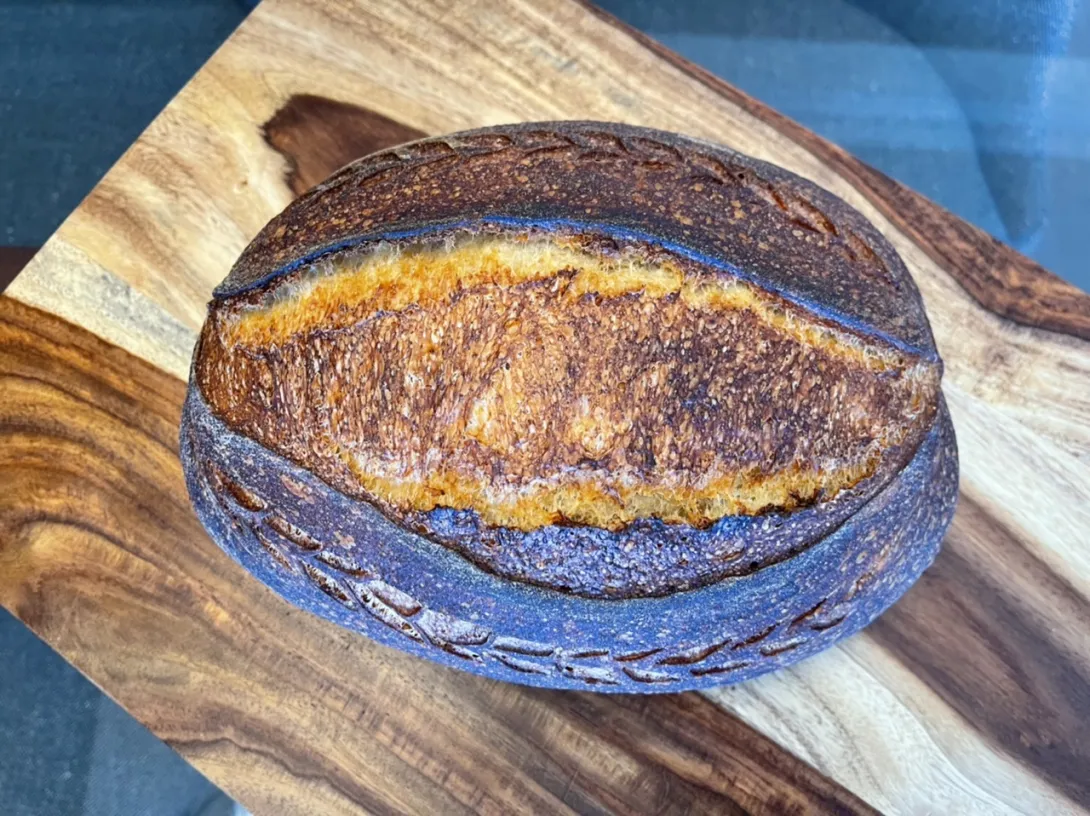
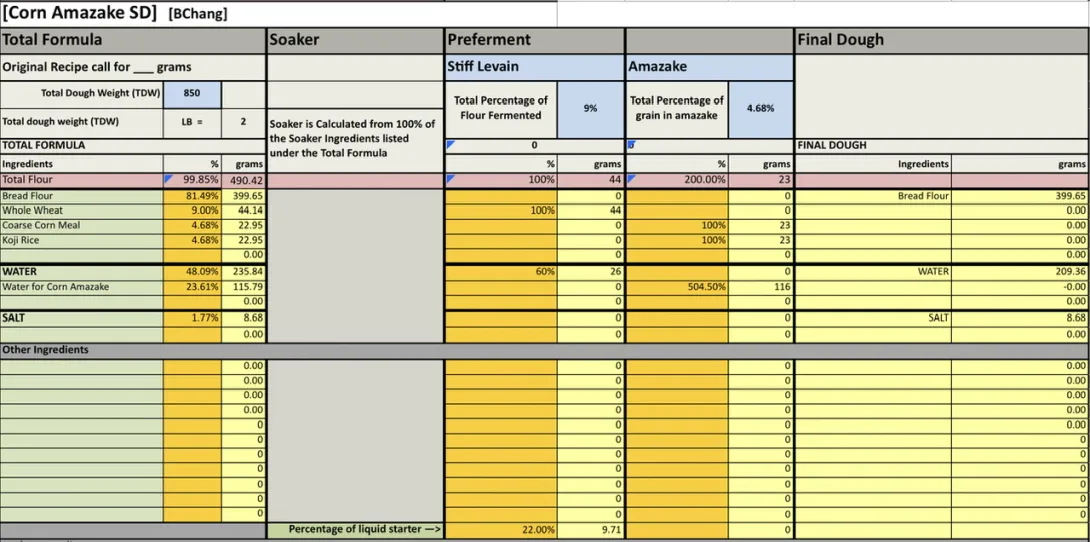
Overnight prep
Prepare corn amazake by cooking the coarse corn meal with the water for amazake. Cool to 150°F or just below then add the koji rice. Place in a jar, stir and cover lightly and allow to ferment at 140°F for 14 hours. I use my Instant Pot using the [Keep Warm] Normal setting with the pot filled with water placing the jar in the water. After 14 hours allow to cool, if you taste it you will find it beautifully sweet. It will appear more runny than it initially was.
Overnight stiff levain
Mix the levain ingredients well and place in a proofing box set to 77-78°F. After 10 hours it was just peaked with the dome starting to flatten.
Dough Mix
Add the corn amazake to a large mixing bowl along with the water and stiff levain. Using your hands or a spatula break the stiff levain into small pieces. Add the flour and mix until no dry flour remain. Autolyze for 20-30 mins. Add the salt on top of the dough, with very wet fingers press the salt into the dough then stretch and fold in the bowl until the dough starts to come together. Place on the wet countertop and slap and fold the dough until moderately well developed, about 250 for my dough. Do a bench letterfold. Optional remove two aliquots of dough one for pH and the other to monitor rise and place each in their own jar.
Bulk Fermentation
Place the dough in a square Pyrex dish and if the dough temperature is less than 82°F then wet the outsides of the aliquot jars and place the aliquot jars in the Pyrex dish with the dough in contact. This is in ensure that the dough temperature in each of the aliquot jars is the same as the main dough. Once the main dough has reached proofing box temperature of 82°F then the aliquot jars can be removed from contact with the dough and placed in the proofing box.
At 30 mins intervals do sets of coil folds, stop when the dough appears strong and no longer relaxes between folds. Aim for 40% rise or a 1.0 drop in pH as the indication to shape your dough.
After shaping aim for a further pH fall of 0.2-0.3 and then cold retard overnight for baking in the morning.
The next day when one hour before baking pre-heat the oven to 500°F with the cast iron skillet in the oven and a Sylvia towel in a metal loaf pan at the ready. 30 mins later add boiling water to the Sylvia towel pan and load into the oven to pre-steam it.
Once oven reaches 500ºF turn dough out of banneton, brush excess rice flour off, score and then brush with water. Transfer to oven. Pour 250 mL of boiling water into the cast iron skillet on a high shelf, high enough that the dough have fully bloom. Drop temperature to 450ºF and bake with steam for 25 mins. Then vent oven and remove all steaming gear and drop temperature to 425ºF. Bake for another 25-30 mins rotating as needed.
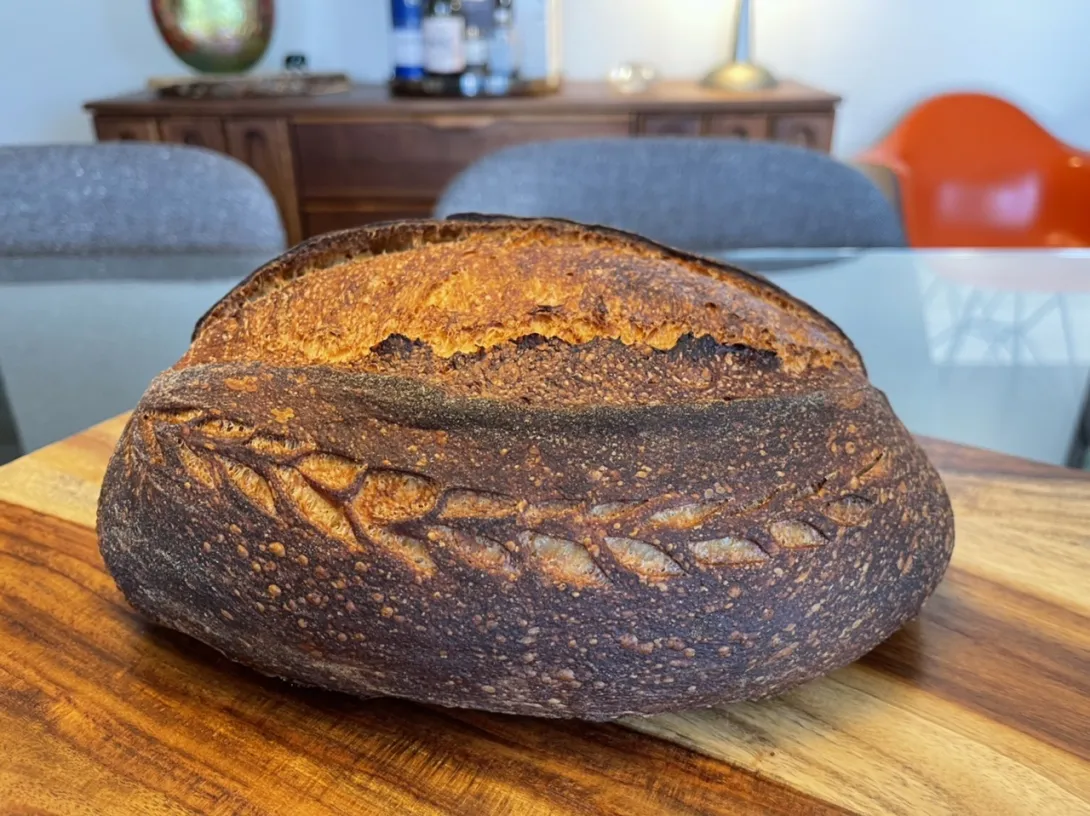
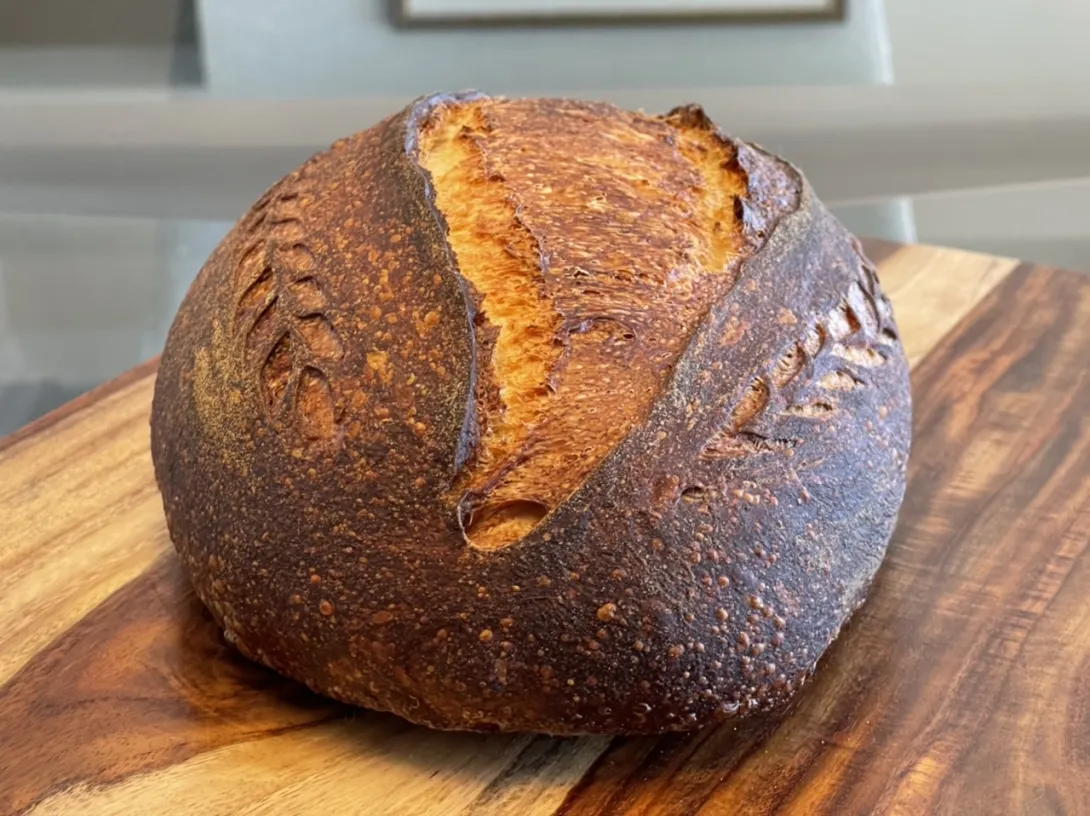
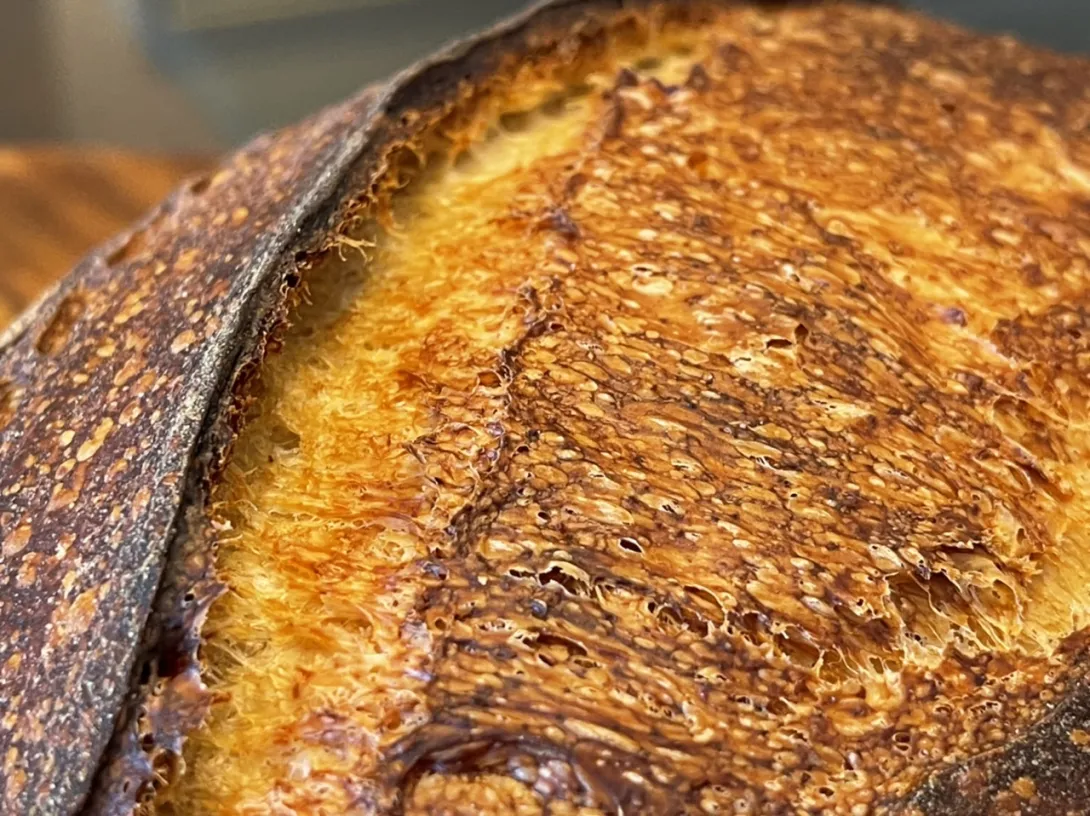
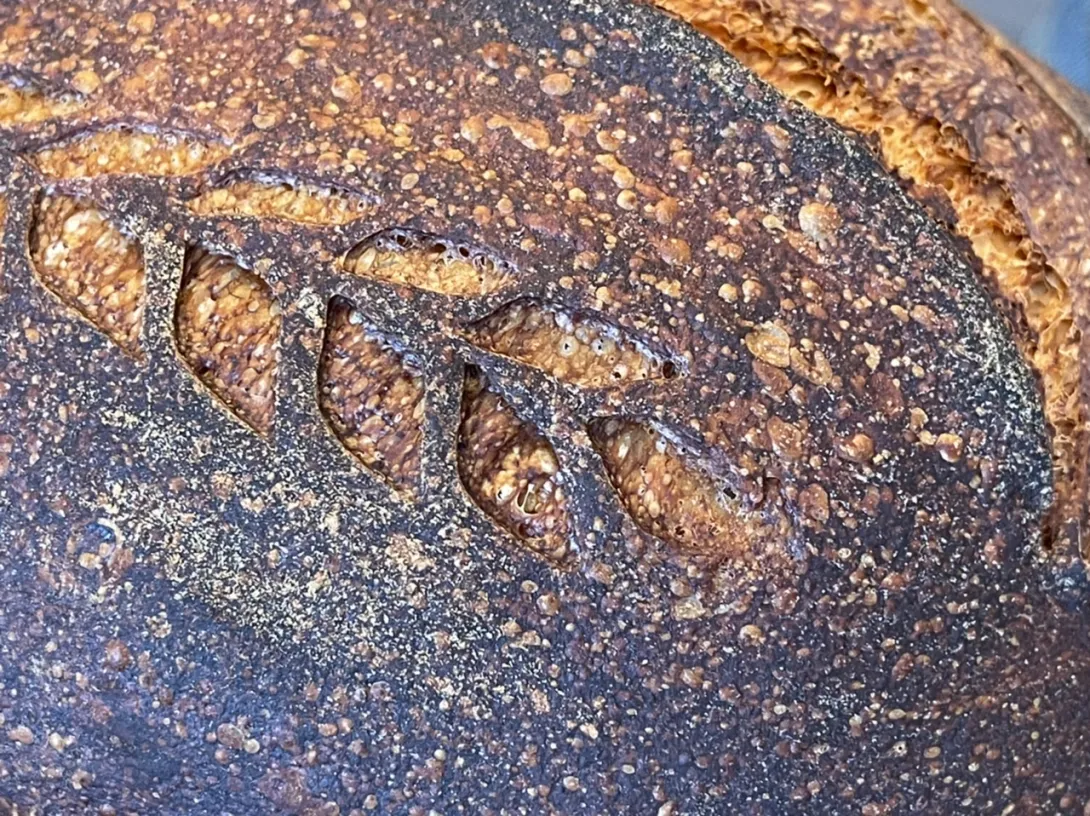
- Benito's Blog
- Log in or register to post comments
Uploaded a couple of videos for those interested in shaping and scoring.
Great looking loaf Benny! Very interesting technique and I like the experimentation! Based on my experience (and I think yours as well), breads with a corn mash progress faster. I think (and this is pure speculation) that the corn just produces more sugar than other grains. This particular prep method may have just pulled out a lot more sugars than you suspect. That suppressing the LAB, combined with any carbon dioxide from the mold, seems like the most likely cause for the lack of pH drop.
Yes that must be it Troy, this corn amazake was definitely sweeter than even the saccharified polenta, I just never imagined that it would be enough to reduce the LAB, but it must have for the relatively lack of pH fall. I wish I remembered to take the pH prior to baking. I'll have to take the pH of a slice when I eventually slice it later.
Benny
Happy with this bake, the crumb is lacy and not too open. Surprisingly it is neither sweet nor sour, I was expecting the corn amazake to make it sweeter than usual, but it is not. The crumb has that lovely soft custard like texture of a porridge loaf.
Wow Benny, the crumb looks just perfect! Amazing!
Thank you Ilya, I’m quite happy with this bake.
Benny
Safe to say you nailed that one…. 😉
Thank you Troy, it was a good bake. Despite it being a bit smaller than usual in weight, it was larger than usual in volume.
I like the look of the lacy crumb. I don’t know anything about the Ph but the fermentation looks spot on. Nice video of the intricate scoring of the wheat stalk. The depth of the center score looked plenty deep to me. Another stellar bake.
Don
Thank you Don, I was quite pleased with the crumb on this one. I was expecting more blisters than I got, not sure why there are fewer blisters than the last polenta loaf. Blisters can be such a mystery to me.
Benny
I have always associated blisters with retarded loaves that go from the fridge to the oven right away. I was surprised to read that you brush the crust with water in addition to the duo steam pan set up in your oven. When I have tried brushing water on before baking it lead to a harder thicker crust, even on a pan loaf. Your bake, for some reason, has a pretty thick crust which may hamper more blisters forming. There seems to be no end to the mysteries of bread baking.
Don
Yes I usually brush water onto the dough prior to steam baking. The main reason I do this is to ensure that there is no rice flour left on the dough because I don’t like seeing or feeling the rice flour on the surface. Interesting that you associate this extra water with a thicker crust, yet another thing to try differently to see if it makes a difference now, thanks Don.
Benny
The crumb looks amazing on this one. Since you said you didn’t really taste any additional sweetness do you think this procedure was worth the effort? Was there any additional corn taste from this method?
I think I would try it again but increase the amount of the amazake corn to taste it more. It was surprisingly sweet when tasting this amazake variant but strangely not when eating the bread. It wasn’t really more effort than the saccharified corn since the instant pot does all the work.
Benny
You've caused some great crumb envy across TFL with this one! I've got some heritage purple corn that I'm wanting to grind and use in a polenta bake...not enough hours in the weekend though. Hoping to circle back to all these bookmarked polenta/cornmeal bakes I've been seeing lately very soon. Thanks for posting another great bake!
Thank you Leigh, I haven’t been baking low whole grain breads much lately so haven’t seen lacy crumb in my bread in a long while so it was nice to see it. Hope you get around to baking a polenta bread, the soft custard like crumb from these porridges is so nice.
Benny